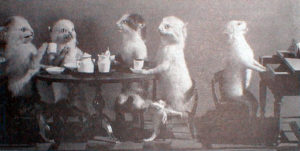We sat down to talk with Monica Flegel about animal studies at VSAWC 2013. Her paper at the conference, “Becoming Crazy Cat Lady: Victorian Spinsters and their Furry Kin,” builds on her work on Victorian animal and children’s rights, with a particular focus on the construction of the spinster and her cat as a type of family.
We asked Dr. Flegel to describe the nature of her research. She noted that, in general, people are under the impression that children acquired rights before animals and thus that animals had fewer rights than children, which isn’t the case. Dr. Flegel argues vehemently that “children’s rights were about making children less like humans and more like animals at the end of the century.”
She briefly discussed the difference between pets and wild animals, and specifically, the domestication hierarchy. Dr. Flegel argues that pets are outside the default human-animal relationship. She suggests that domesticated animals do not represent nor symbolize the “true” animal, that the comparison is too simplistic. Pets, she says, “have a place in human culture, and can trouble concepts of the nuclear family.”
We asked about her stance on the controversial concept of humans and other animals, and “nonhuman animals.” Dr. Flegel contends that the term “nonhuman animals” suggests a speciesist approach. “Materially, we do not live in the way that animals do,” she argues, “as Derrida said, there is an abyss between us and other animals,” but she points out the divide between animals and humans is not meant to suggest that humans are “better, and other, and higher” than animals; rather, it suggests that our alterity cannot be bridged “by saying that we are animals too.” Moreover, we can still have “ethical relations with animals without [suggesting] that we are all animals together.”
Monica Flegel
Monica Flegel is an associate professor in the Department of English at Lakehead University in Thunder Bay, Ontario. Her research interests include Victorian studies, cultural studies, and children and animals. Dr. Flegel holds a bachelor of arts in honours English from the University of Saskatchewan, a master’s degree in English from Dalhousie University, and a PhD of English from the University of Alberta. Her current research on Victorian pets is funded by the Social Sciences and Humanities Research Council of Canada.

